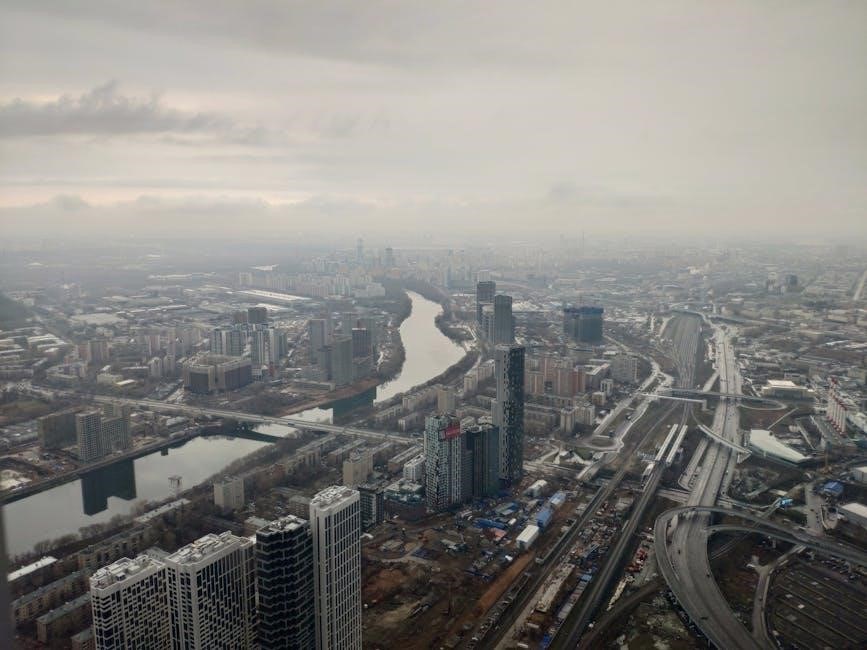Grey areas in globalization refer to regions or situations where norms, laws, and economic structures are ambiguous or undefined, creating complexities in governance and international relations.

1.1. Definition of Grey Areas
Grey areas, often referred to as “zones grises,” are regions or situations characterized by ambiguity, where norms, laws, and economic structures are unclear or poorly defined.
These areas exist outside traditional legal and governance frameworks, creating challenges for international relations and economic systems. They are frequently associated with failed states, geopolitical instability, and informal markets. The concept is closely tied to globalization, where such zones emerge due to the complexities of cross-border interactions. Grey areas operate in the spaces between formal and informal systems, often exploiting legal loopholes or weak regulatory environments. They are not entirely outside the global system but exist within it, influencing trade, politics, and social dynamics. Understanding these zones is crucial for addressing issues like corruption, illegal activities, and economic inequality. The term “zones grises” emphasizes the blurred boundaries between order and chaos, making them a critical focus in studies of globalization and governance.
1.2. Historical Context of Grey Zones
The concept of grey zones has deep historical roots, often tied to periods of geopolitical instability and economic transformation.
Historically, these areas emerged during colonialism, where colonial powers created administrative ambiguities, leaving certain regions ungoverned or loosely controlled. Post-colonial states often inherited these challenges, leading to failed states and unstable regions. The term gained prominence in the 20th century, particularly during the Cold War, as proxy states and contested territories became focal points of global power struggles. Economic globalization further exacerbated the issue, as transnational flows of goods and capital exploited legal ambiguities in these zones. The rise of informal markets and shadow economies in these regions has been documented, highlighting their resilience and adaptability. Today, grey zones remain a critical issue, influencing global security, trade, and governance, with ongoing debates on how to address their complexities. Their historical evolution underscores their enduring impact on international relations and economic systems.
1.3. Importance of Understanding Grey Areas
Understanding grey areas is crucial for addressing the complexities they introduce in globalization, governance, and economic systems.
These zones often serve as hotbeds for illicit activities, such as illegal trade and financial fraud, which can destabilize global markets. By studying grey areas, policymakers can develop targeted strategies to mitigate risks and enhance regulatory frameworks. Additionally, these regions highlight disparities in development, prompting initiatives to promote equitable growth. Ignoring grey areas can lead to prolonged instability, undermining international cooperation and security. Therefore, comprehending their dynamics is essential for fostering sustainable development and ensuring global stability.
1.4. Relevance of Grey Areas in Modern Globalization
Grey areas play a significant role in modern globalization, as they represent regions or situations where traditional norms, laws, and economic structures are ambiguous or undefined. These zones often emerge in failed states or areas with weak governance, where central institutions lack control. The rise of informal markets, shadow economies, and tax havens further underscores the relevance of grey areas in today’s interconnected world. Such regions frequently become hotbeds for illicit activities, undermining global trade and stability. Understanding these zones is crucial for addressing geopolitical instability, economic disparities, and legal ambiguities. Moreover, grey areas highlight the challenges of regulating emerging technologies and ensuring ethical standards in innovation. As globalization deepens, the need to address these ambiguous regions becomes increasingly vital for fostering equitable development and maintaining international security. Their relevance lies in their ability to shape global dynamics, requiring targeted strategies from policymakers and organizations.

Grey Areas in International Relations
Grey areas in international relations exist in regions with weak governance or conflict, where legal frameworks are ambiguous. These zones challenge state sovereignty and international cooperation frameworks.
2.1. Failed States and Their Role in Grey Areas
Failed states significantly contribute to the emergence of grey areas in globalization. These states, characterized by weak governance, political instability, and economic collapse, create environments where legal frameworks are ambiguous. Without effective central authority, regions within these states often become zones where informal economies, illegal activities, and non-state actors thrive. The absence of robust institutions allows for the exploitation of resources and the rise of criminal networks. Additionally, failed states often lack the capability to enforce international laws, leading to jurisdictional challenges. This creates a breeding ground for grey areas, as neither domestic nor international systems can effectively regulate these regions. The intersection of political instability and economic desperation fosters an environment conducive to the growth of grey zones, making them challenging to address within the global governance framework.
2.2. Geopolitical Instability in Grey Zones
Geopolitical instability is a defining feature of grey zones, where weak governance and contested authority create fertile ground for conflict. These regions often lie at the intersection of competing interests, making them vulnerable to external interventions and internal power struggles. The absence of a strong central authority allows non-state actors, such as armed groups or criminal organizations, to exploit resources and exert influence. This instability is further exacerbated by the lack of clear borders or jurisdictional frameworks, leading to a perpetual state of ambiguity. Grey zones frequently emerge in areas rich in strategic resources or located along critical trade routes, making them hotspots for both local and international tensions. The ongoing competition for control in these regions perpetuates cycles of violence and undermines efforts to establish stable governance, rendering grey zones persistent challenges in global geopolitics.
2.3. The Concept of “Zone Grise” in International Law
The concept of “zone grise” in international law refers to areas or situations where legal frameworks are ambiguous, creating challenges for state and non-state actors. These zones often exist in regions with weak governance or contested sovereignty, where traditional legal systems fail to provide clear jurisdictional boundaries. The term is closely associated with failed states and regions where central authority is absent or fragmented. International law struggles to address these areas effectively, as they often fall outside the scope of conventional legal frameworks. The ambiguity in these zones can lead to conflicts over territorial claims, resource exploitation, and human rights issues. Furthermore, the lack of clear legal definitions makes it difficult for international organizations to intervene or enforce norms. As a result, “zones grises” remain a significant challenge in maintaining global governance and stability.
2.4. Case Studies of Grey Areas in Global Politics
Grey areas in global politics are often illustrated through specific case studies that highlight ambiguity and conflict. One notable example is the Arctic region, where melting ice has led to overlapping territorial claims among nations, creating legal and political challenges. Another case is the Kashmir region, disputed between India and Pakistan, with areas under different administrative controls, leading to complex governance issues. Additionally, the Israel-Palestine conflict exemplifies a grey area, with territories subject to varying degrees of autonomy and sovereignty. These case studies demonstrate how grey areas arise from historical disputes, environmental changes, and political complexities, making them critical for understanding the nuances of global governance and diplomacy;

Economic Grey Areas

Economic grey areas involve informal markets, tax havens, and shadow economies, where financial activities operate outside formal regulatory frameworks, creating challenges for global trade and financial stability.
3.1. Informal Markets and Shadow Economies
Informal markets and shadow economies thrive in grey areas, operating outside formal regulatory systems. These activities range from unregistered businesses to illegal trade, often driven by economic necessity or evasion of taxes. According to a PDF document titled “Les PMA, les États faillis et les zones grises de la mondialisation,” such markets are prevalent in regions with weak governance and economic instability. Shadow economies undermine official statistics, making it difficult for governments to assess true economic conditions. Additionally, zones grises in global trade, as discussed in various reports, contribute to financial ambiguities, complicating efforts to regulate and tax these activities effectively. These markets highlight the challenges of addressing economic grey areas in a globalized world.
3.2. Financial Regulation and Ambiguities
Financial regulation faces significant challenges in grey areas, where legal and economic ambiguities create gaps in oversight. A PDF document highlights how zones grises in globalization often involve unclear jurisdictions, enabling activities like tax evasion and money laundering. These ambiguities stem from differing legal frameworks across nations, as noted in a report by Kesselman (2020). For instance, offshore economies and tax havens exploit these gaps, complicating global financial regulation. The lack of uniformity in laws allows entities to operate in legal “grey zones,” undermining efforts to enforce financial transparency. This ambiguity not only hampers economic stability but also poses risks to global trade, as highlighted in studies on failed states and informal markets. Addressing these challenges requires international cooperation and clearer regulatory frameworks to minimize the impact of financial grey areas.
3.3. Tax Havens and Offshore Economies
Tax havens and offshore economies are quintessential examples of grey areas in globalization, operating in legal ambiguities that allow entities to minimize tax liabilities. A PDF document reveals that these jurisdictions exploit gaps in international tax laws, creating “zones grises” where financial activities remain loosely regulated. According to Kesselman (2020), such economies thrive due to secrecy and low-tax environments, attracting both legitimate businesses and illicit operations. The lack of transparency in these regions complicates global financial regulation, as highlighted in a report by GRISE. Offshore economies not only impact national revenues but also contribute to economic instability, as they often bypass oversight mechanisms. Efforts to address these issues require enhanced international cooperation and standardized legal frameworks to reduce the influence of these grey areas in the global economy.
3.4. The Impact of Economic Grey Areas on Global Trade
Economic grey areas significantly influence global trade by creating distortions in market dynamics. These regions, often characterized by ambiguous regulations and tax havens, attract businesses seeking cost advantages, as noted in a PDF document. While they may stimulate economic activity, they also undermine fair competition and lead to revenue losses for nations with stricter regulations. A report by GRISE highlights how such areas facilitate illicit financial flows, complicating global trade balances. Additionally, the lack of transparency in these economies hinders efforts to combat fraud and corruption, further destabilizing international trade systems. Addressing these challenges requires robust international cooperation and standardized frameworks to regulate grey areas effectively, ensuring a more equitable global trade environment.

Legal and Regulatory Grey Areas
Legal grey areas involve ambiguities in laws and regulations, creating challenges in jurisdiction and enforcement. These zones often arise from conflicting legal frameworks or unclear international agreements, complicating governance and compliance.
4.1. Ambiguities in International Law
Ambiguities in international law often stem from vague treaty provisions, conflicting legal frameworks, or unclear jurisdictional boundaries. These grey areas create challenges in interpreting and enforcing laws globally. For instance, the concept of “failed states” and “zones grises” highlights regions where legal systems are weak or absent, leading to governance gaps. International organizations like the UN and WTO face difficulties in addressing these ambiguities due to differing interpretations of sovereignty and jurisdiction. Additionally, the rise of new technologies and cross-border issues further complicates legal frameworks. Efforts to clarify these ambiguities are ongoing, but the complexity of global interactions often leaves significant room for interpretation, undermining the effectiveness of international law in addressing grey areas.
4.2. Jurisdictional Challenges in Grey Zones
Jurisdictional challenges in grey zones arise when legal authorities struggle to define and enforce their control over ambiguous regions. These areas often lack clear governance, leading to conflicts over legal jurisdiction. For instance, failed states or regions with weak governance create voids where multiple legal systems may claim authority, resulting in overlapping or competing jurisdictions. International organizations face difficulties in mediating these disputes due to varying interpretations of sovereignty and territorial rights. Additionally, the rise of cross-border issues, such as cybercrime and multinational corporations, further complicates jurisdictional boundaries. Tax havens and offshore economies exemplify grey zones where legal ambiguities allow entities to exploit gaps in international law. Addressing these challenges requires coordinated efforts between nations and international bodies to establish clearer frameworks and resolve jurisdictional disputes effectively.

4.3. The Role of International Organizations
International organizations play a pivotal role in addressing grey areas by providing frameworks and mediating disputes. They work to establish norms and regulations that clarify ambiguous regions and situations. For example, organizations like the United Nations and the World Bank support governance in failed states, helping to rebuild institutional capacity. They also facilitate dialogue between nations to resolve jurisdictional challenges and promote cooperation. Additionally, these entities often fund research and initiatives aimed at understanding and mitigating the impact of grey zones. Their efforts contribute to global stability by addressing legal and economic ambiguities, ensuring that grey areas do not become sources of conflict or exploitation. Through their interventions, international organizations strive to create a more structured and equitable global system, reducing the challenges posed by grey zones.
4.4. Enforcement of Laws in Grey Areas
Enforcing laws in grey areas is challenging due to ambiguous jurisdictions and lack of clear legal frameworks. International organizations and governments often struggle to apply laws effectively in these zones. Limited resources, political instability, and conflicting interests further complicate enforcement. Grey areas may lack centralized authority, making it difficult to implement and monitor legal measures. Additionally, the absence of clear regulations leads to inconsistent law enforcement, creating opportunities for illegal activities. To address this, collaborative efforts between nations and international bodies are essential. Strengthening legal frameworks and increasing transparency can help improve enforcement. However, the dynamic nature of grey areas requires adaptive strategies that evolve with changing circumstances. Effective enforcement in these zones is critical to maintaining global order and ensuring justice for affected communities.

Grey Areas in Psychiatry and Psychology

Grey areas in psychiatry and psychology refer to ambiguous diagnostic conditions and treatment challenges, where symptoms or behaviors do not fit clearly defined mental health categories, complicating care and intervention strategies.
5.1. Diagnostic Challenges in Mental Health
Diagnostic challenges in mental health are prevalent in grey areas, where symptoms overlap or fall between defined categories, making accurate diagnoses difficult. This ambiguity often leads to misdiagnoses or delayed treatment. For instance, conditions like borderline personality disorder or mild neurocognitive disorders may present with symptoms that do not neatly align with standard diagnostic criteria. Additionally, cultural and individual variations in symptom expression further complicate the process. Mental health professionals must rely on extensive clinical judgment and sometimes multiple assessments to navigate these uncertainties. The lack of clear boundaries in symptoms can also lead to disagreements among professionals, highlighting the need for ongoing research and updated diagnostic frameworks to address these grey areas effectively.
5.2. The Concept of “Zone Grise” in Psychiatry
The concept of “zone grise” in psychiatry refers to ambiguous or unclear mental health conditions that do not fit neatly into established diagnostic categories. These grey areas often involve subtle or overlapping symptoms that make it challenging to pinpoint a specific disorder. For example, conditions like subthreshold depression or mild cognitive impairment exist in a grey zone between normal functioning and clinically significant disorders. This ambiguity can lead to diagnostic uncertainty and variability among professionals. Patients in these zones may experience delays in receiving appropriate treatment or face challenges in accessing mental health services. The “zone grise” highlights the complexity of mental health and the need for a more nuanced approach to diagnosis and care. It underscores the importance of clinical judgment and the limitations of current diagnostic frameworks in addressing these ambiguous cases effectively.
5.3. Treatment Options for Ambiguous Conditions
Treating ambiguous conditions in psychiatry, often referred to as “zones grises,” presents unique challenges due to their unclear or overlapping symptoms. These conditions frequently require adaptive and personalized approaches, as standard treatment protocols may not apply. Clinicians often adopt a multidisciplinary strategy, combining psychotherapy, medication, and lifestyle adjustments tailored to the patient’s specific needs. Cognitive-behavioral therapy (CBT) and mindfulness-based interventions are commonly used to address symptoms that don’t fit neatly into defined diagnostic categories. Additionally, collaborative care models involving psychiatrists, psychologists, and social workers can provide comprehensive support. The lack of clear guidelines for these ambiguous conditions underscores the importance of clinical judgment and patient-centered care. Treatment plans must remain flexible, with ongoing monitoring to adapt to evolving symptoms or diagnostic clarity. Ultimately, the goal is to improve quality of life and functioning, even when a definitive diagnosis remains elusive.
5.4. The Impact of Grey Areas on Mental Health Policy
The existence of grey areas in psychiatry significantly influences mental health policy, as ambiguous conditions challenge traditional diagnostic and treatment frameworks. These zones grises often lead to delays in appropriate care, as clinicians struggle to assign clear diagnoses. This ambiguity can result in inconsistent treatment protocols and disparities in access to mental health services. Policymakers face difficulties in allocating resources effectively, as the lack of clear definitions complicates the creation of targeted interventions. Additionally, grey areas may lead to over- or under-treatment, raising ethical concerns and increasing healthcare costs. Addressing these challenges requires flexible policy frameworks that accommodate uncertainty and promote collaboration between clinicians, researchers, and policymakers. By acknowledging and adapting to grey areas, mental health systems can better serve individuals with ambiguous conditions, ensuring equitable and effective care.

Grey Areas in Technology and Innovation
Grey areas in technology and innovation arise from ethical dilemmas, regulatory ambiguities, and the rapid pace of advancements, creating challenges in governance and societal adaptation to new developments.
6.1. Ethical Dilemmas in Emerging Technologies
Ethical dilemmas in emerging technologies often exist in grey areas where societal norms and legal frameworks have not yet adapted to address their implications. For instance, artificial intelligence raises questions about bias, privacy, and accountability. Similarly, advancements in biotechnology, such as gene editing, pose ethical concerns regarding human enhancement and genetic equity. These technologies frequently outpace regulatory systems, creating ambiguity in how they should be governed. As a result, stakeholders must navigate complex moral landscapes, balancing innovation with responsibility. Addressing these dilemmas requires collaborative efforts between technologists, policymakers, and ethicists to establish guidelines that mitigate risks while fostering progress. The absence of clear ethical standards can lead to misuse or unintended consequences, emphasizing the need for proactive dialogue and frameworks to manage these evolving challenges.
6.2. Regulatory Challenges in Tech Innovation
Regulatory challenges in tech innovation often arise in grey areas where existing laws and frameworks fail to address new technologies adequately. For instance, advancements in artificial intelligence, blockchain, and biotechnology frequently outpace legal systems, creating ambiguity and uncertainty. Governments and regulatory bodies struggle to balance innovation with oversight, particularly in areas like data privacy, intellectual property, and ethical standards. These challenges are compounded by the global nature of technology, which often transcends national jurisdictions. Additionally, the lack of clear guidelines can lead to legal disputes and hinder the adoption of innovative solutions. Addressing these challenges requires collaborative efforts between policymakers, technologists, and stakeholders to develop adaptive and forward-thinking regulations that foster innovation while mitigating risks. The absence of robust frameworks can result in regulatory gaps, further complicating the landscape of technological advancement.
6.3. The Role of AI in Addressing Grey Areas
AI plays a pivotal role in navigating and addressing grey areas by providing analytical insights and automating decision-making processes. In ambiguous environments, AI can analyze vast amounts of data to identify patterns and predict outcomes, helping to clarify uncertainties. For instance, AI-driven systems can assist in interpreting complex legal frameworks, offering solutions where traditional regulations fall short. Additionally, AI enables real-time monitoring and adaptation, which is crucial in dynamic grey zones. However, the use of AI in these contexts also raises ethical concerns, such as bias in algorithms and the potential for misuse. Despite these challenges, AI remains a powerful tool for mitigating ambiguities and fostering innovation in grey areas. Its ability to process and interpret complex information makes it indispensable in addressing the uncertainties inherent in these zones.
6.4. The Future of Grey Areas in Technological Advancements
The future of grey areas in technological advancements lies in the rapid evolution of innovations that blur boundaries between clear and ambiguous zones. As technologies like AI, quantum computing, and biotechnology progress, they create new ethical, legal, and regulatory challenges. Grey areas will expand in domains such as cybersecurity, data privacy, and intellectual property, where existing frameworks struggle to keep pace. Emerging technologies will also uncover unexplored territories, forcing governments and organizations to redefine norms and laws. However, these advancements also offer solutions to existing grey areas, enabling more precise monitoring and regulation. The interplay between technological growth and ambiguity will shape global policies and innovation ecosystems. Ultimately, the future of grey areas is intertwined with humanity’s ability to adapt and govern cutting-edge technologies responsibly.


